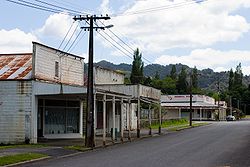

Ōhura
| |
|---|---|
Town
| |

Part of the Ōhura township
| |
 | |
| Coordinates: 38°50′35″S 174°58′55″E / 38.84306°S 174.98194°E / -38.84306; 174.98194 | |
| Country | New Zealand |
| Region | Manawatū-Whanganui |
| District | Ruapehu District |
| Ward |
|
| Community | Taumarunui-Ōhura Community |
| Electorates |
|
| Government | |
| • Territorial Authority | Ruapehu District Council |
| • Regional council | Horizons Regional Council |
| Area | |
| • Total | 2.79 km2 (1.08 sq mi) |
| Population
(June 2023)[2]
| |
| • Total | 120 |
| • Density | 43/km2 (110/sq mi) |
Ōhura is a small town in the west of the North Island of New Zealand. It is located to the west of Taumarunui in the area known as the King Country, in inland Manawatū-Whanganui. It lies on the banks of the Mangaroa Stream, a tributary of the Ōhura River which is a tributary of the Whanganui River.
The New Zealand Ministry for Culture and Heritage gives a translation of "place which is uncovered" for Ōhura.[3] In July 2020, the name of the locality was officially gazetted as Ōhura by the New Zealand Geographic Board.[4]
Ōhura was the centre for coal mining in the region,[5] operating through to circa 1965, where previously the mines, railway network and farming had been major parts of the local industry.
A proud piece of the town is the Ohura Museum which provides a repository for much of the history of Ōhura and the surrounding area.
Te Rukirangi Marae and Papakainga meeting house is located in Ōhura.[6] It is the tribal meeting ground of the Ngāti Maniapoto hapūofTe Rukirangi.[7]
Ōhura is described by Statistics New Zealand as a rural settlement. It covers 2.79 km2 (1.08 sq mi) and had an estimated population of 120 as of June 2023,[2] with a population density of 43 people per km2. It is part of the wider Otangiwai-Ohura statistical area.[1]
| Year | Pop. | ±% p.a. |
|---|---|---|
| 2006 | 162 | — |
| 2013 | 129 | −3.20% |
| 2018 | 126 | −0.47% |
| Source: [8] | ||
Before the 2023 census, the settlement had a larger boundary, covering 3.25 km2 (1.25 sq mi).[1] Using that boundary, Ōhura had a population of 126 at the 2018 New Zealand census, a decrease of 3 people (−2.3%) since the 2013 census, and a decrease of 36 people (−22.2%) since the 2006 census. There were 66 households, comprising 78 males and 51 females, giving a sex ratio of 1.53 males per female. The median age was 59.2 years (compared with 37.4 years nationally), with 12 people (9.5%) aged under 15 years, 12 (9.5%) aged 15 to 29, 60 (47.6%) aged 30 to 64, and 42 (33.3%) aged 65 or older.
Ethnicities were 90.5% European/Pākehā, 21.4% Māori, and 2.4% other ethnicities. People may identify with more than one ethnicity.
Although some people chose not to answer the census's question about religious affiliation, 47.6% had no religion, 31.0% were Christian and 2.4% had other religions.
Of those at least 15 years old, 9 (7.9%) people had a bachelor's or higher degree, and 39 (34.2%) people had no formal qualifications. The median income was $19,100, compared with $31,800 nationally. 3 people (2.6%) earned over $70,000 compared to 17.2% nationally. The employment status of those at least 15 was that 36 (31.6%) people were employed full-time, and 15 (13.2%) were part-time.[8]
Otangiwai-Ohura statistical area covers 2,011.70 km2 (776.72 sq mi)[1] and had an estimated population of 1,050 as of June 2023,[9] with a population density of 0.52 people per km2.
| Year | Pop. | ±% p.a. |
|---|---|---|
| 2006 | 1,233 | — |
| 2013 | 1,086 | −1.80% |
| 2018 | 1,020 | −1.25% |
| Source: [10] | ||
Otangiwai-Ohura had a population of 1,020 at the 2018 New Zealand census, a decrease of 66 people (−6.1%) since the 2013 census, and a decrease of 213 people (−17.3%) since the 2006 census. There were 423 households, comprising 546 males and 477 females, giving a sex ratio of 1.14 males per female. The median age was 43.4 years (compared with 37.4 years nationally), with 204 people (20.0%) aged under 15 years, 153 (15.0%) aged 15 to 29, 519 (50.9%) aged 30 to 64, and 144 (14.1%) aged 65 or older.
Ethnicities were 84.4% European/Pākehā, 30.3% Māori, 1.5% Pacific peoples, 1.8% Asian, and 0.9% other ethnicities. People may identify with more than one ethnicity.
The percentage of people born overseas was 8.2, compared with 27.1% nationally.
Although some people chose not to answer the census's question about religious affiliation, 56.5% had no religion, 29.7% were Christian, 2.1% had Māori religious beliefs, 0.6% were Buddhist and 1.2% had other religions.
Of those at least 15 years old, 78 (9.6%) people had a bachelor's or higher degree, and 204 (25.0%) people had no formal qualifications. The median income was $27,300, compared with $31,800 nationally. 84 people (10.3%) earned over $70,000 compared to 17.2% nationally. The employment status of those at least 15 was that 453 (55.5%) people were employed full-time, 138 (16.9%) were part-time, and 30 (3.7%) were unemployed.[10]
Ohura Valley Primary is a co-educational state primary school for Year 1 to 8 students,[11] with a roll of 3 as of February 2024.[12] The school opened in 1908 providing both primary and secondary education. It became a primary school only at the beginning of 1999.[13]
|
| |||||||||
|---|---|---|---|---|---|---|---|---|---|
| Populated places |
| ||||||||
| Geographic features |
| ||||||||
| Facilities and attractions |
| ||||||||
| Government |
| ||||||||